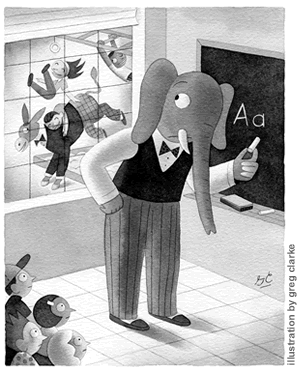 Project Head Start was created during the heady, idealistic days of the mid-1960s. Through two seminal victories, the 1954 Brown v. Board of Education decision and the Civil Rights Act of 1964, the civil-rights movement had won equality in the eyes of the law, but the economic and social legacies of centuries of slavery and racial discrimination remained. President Lyndon Johnson believed that it was the nation’s duty to provide not just legal equality but also equality of opportunity. In his 1965 commencement address at Howard University, he called for the “next and the more profound stage” in the civil-rights struggle. “We seek not just freedom but opportunity. . . not just equality as a right and a theory but equality as a fact and equality as a result.” Johnson’s War on Poverty would include a host of initiatives designed to bring blacks and other disadvantaged Americans to what he called “the starting line” of American life with the skills and abilities necessary to compete on a level playing field. The War on Poverty focused on education as a tool for upward mobility, and Head Start was to become one of the cornerstones of the federal effort.
Project Head Start was created during the heady, idealistic days of the mid-1960s. Through two seminal victories, the 1954 Brown v. Board of Education decision and the Civil Rights Act of 1964, the civil-rights movement had won equality in the eyes of the law, but the economic and social legacies of centuries of slavery and racial discrimination remained. President Lyndon Johnson believed that it was the nation’s duty to provide not just legal equality but also equality of opportunity. In his 1965 commencement address at Howard University, he called for the “next and the more profound stage” in the civil-rights struggle. “We seek not just freedom but opportunity. . . not just equality as a right and a theory but equality as a fact and equality as a result.” Johnson’s War on Poverty would include a host of initiatives designed to bring blacks and other disadvantaged Americans to what he called “the starting line” of American life with the skills and abilities necessary to compete on a level playing field. The War on Poverty focused on education as a tool for upward mobility, and Head Start was to become one of the cornerstones of the federal effort.
The idea for Head Start, a preschool program for disadvantaged children, emerged from the observation that, on average, poor and minority children arrive at school already behind their peers in the intellectual skills and abilities required for academic achievement. These deficits in turn lead to poor performance in school, which narrows the economic opportunities disadvantaged children encounter when they become adults. In order to counteract the corrosive influences of turbulent neighborhoods, shoddy health care, and undereducated parents, Head Start would attempt to prepare children to flourish in school.
Nearly 40 years after its creation, Head Start has gained the favor of Democrats and Republicans alike. Its budget in 2003 was $6.7 billion, more than tripling (in real terms) since 1990 (see Figure 1 and Table 1). Real per-pupil spending increased from $1,380 in 1966 to $7,170 in 2002. However, despite Head Start’s long history and ever-expanding budget, the achievement gap between advantaged and disadvantaged, between white and minority, is still substantial, both during the preschool years and thereafter. This stubborn fact has caused many to question Head Start’s strategies and direction. Housed in the Department of Health and Human Services, Head Start has in the past emphasized not just early education but also socialization and giving poor children and their families access to an array of nutritional, health, and social services.
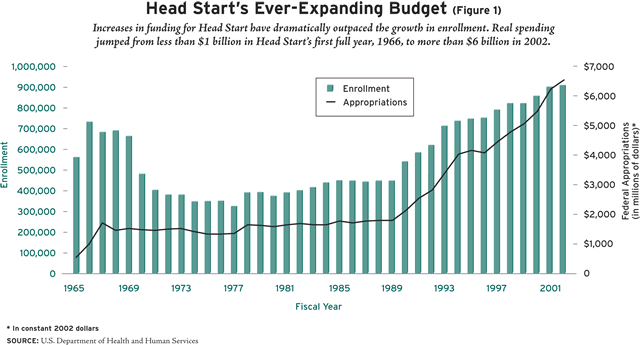
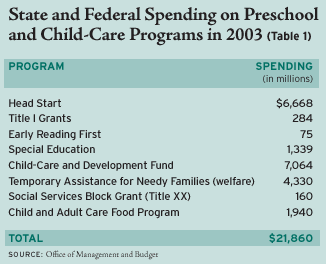 |
Now the Bush administration has proposed reorienting the program to emphasize the acquisition of intellectual skills and to prepare poor kids for school. In order to achieve this objective, the administration is trying to align Head Start more closely with the public school system. After less than a year in office, President Bush implemented by administrative rule a program called “Good Start, Grow Smart,” the central thrust of which is to instruct Head Start teachers across the nation in methods for improving school readiness. The program also helps local Head Start centers develop an accountability system that assesses children’s learning in literacy, language, and numeracy. The administration had made an earlier proposal to move Head Start to the Department of Education, which would have signaled the program’s new commitment to intellectual development. But after encountering fierce competition, in February 2003, the administration proposed an even more dramatic overhaul of Head Start. The plan is to turn control of Head Start over to the states, as long as they commit to making school readiness the program’s chief priority and to meet several other requirements. Currently, federal funds flow directly to local Head Start centers, which are run primarily by community-based groups. As a result, Head Start teachers, staff, and parents, working through the National Head Start Association in Washington, have viscerally opposed the administration’s proposals, fearing the dilution of Head Start’s program of comprehensive services in favor of the focus on school readiness. They regard this as a repudiation of Head Start’s historical mission as well as a threat to their control of the program. The Bush proposal, now before Congress, has rekindled a debate that began in 1964.
The Cooke Committee
In that year, Sargent Shriver, a holdover from the Kennedy administration who became one of the chief architects of Johnson’s War on Poverty, developed the idea for Head Start from his involvement in programs for retarded children (his wife, Eunice, would later found the Special Olympics). Shriver had visited a remarkable project conducted by Dr. Susan Gray of George Peabody College for Teachers in Nashville (which later merged with Vanderbilt University). Gray’s project was one of the first preschool education programs in the nation to be carefully evaluated, and Shriver claimed that it demonstrated that early intervention could “change the IQ of mentally retarded children.” If this were possible, Shriver thought, why couldn’t high-quality preschool also improve the IQ scores of poor children who seemed destined to fail in school?
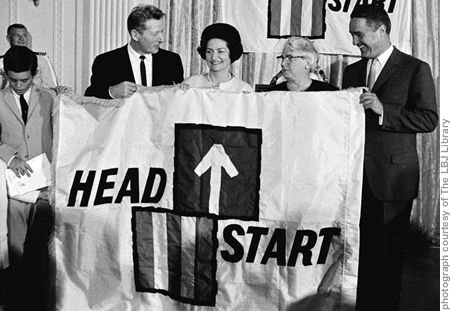 |
| Unexpectedly departing from the public statements of Lyndon Johnson and Sargent Shriver, the Cooke committee recommended that Head Start avoid focusing simply on school preparation or IQ development.
|
In the late fall of 1964, Shriver asked Dr. Robert Cooke, a pediatrician at Johns Hopkins and the chairman of the Kennedy Foundation’s scientific advisory committee, to head a committee whose task would be to make recommendations for a preschool program that would promote the development and school readiness of disadvantaged children. Shriver was in a hurry. With President Johnson’s blessing, he had decided to begin the new program the next summer.
Cooke’s committee, which met several times in January and February of 1965, had a free hand in designing Head Start, which became the best known and most popular of the War on Poverty programs. Unexpectedly departing from the public statements of Johnson and Shriver, the Cooke committee recommended that Head Start avoid focusing simply on school preparation or IQ development. Instead, Head Start was to offer “comprehensive” services, including health care, mental health services, nutrition, preschool education, and parental involvement. Addressing all the child’s needs was thought to have a greater impact on children’s development, including their intellectual development, than education alone. Almost none of the present programs that promote children’s health and welfare, such as Medicaid and the food-stamp and child-nutrition programs, existed in 1965. In that light, recommending comprehensive services was prescient of the Cooke committee.
Much of the thinking at the time was influenced by J. McVicker Hunt’s Intelligence and Experience and Benjamin Bloom’s Stability and Change in Human Characteristics, both of which questioned the popular view that intelligence was immutable. There was an increasing faith that social programs could produce sizable gains in IQ scores. Unfortunately, the first major evaluation of Head Start, published in 1969, failed to find permanent IQ gains, thereby raising the question of whether Head Start was incapable of influencing intellectual development or was just implemented poorly. The Cooke committee’s decision to make Head Start a comprehensive program enabled its defenders to fudge the issue by arguing that the major goals of the program included many activities crucial to a child’s development, such as providing better nutrition and health screening, other than trying to improve IQ scores. The fudging continues to this day.
Another important recommendation made by the Cooke committee was that Head Start funds should travel directly from the federal government to local communities, bypassing the states. This prevented racist governors in the South from killing the program and enabled Head Start to get off the ground quickly. The professionals on the Cooke committee wanted to start small and build up gradually, but Johnson and Shriver were operating on the political logic that called for mounting the biggest program possible, given the money and political will available in the spring and summer of 1965. Amazingly enough, by the early summer of 1965, just four months after the Cooke committee recommended the Head Start program to Shriver, the Johnson administration had funded programs in more than 2,500 communities that enrolled 560,000 children.
Practically overnight, the rapid outflow of funds created a large constituency for Head Start. Most congressional districts housed at least one Head Start program. Thus when trouble came–as it inevitably would–Head Start had advocates from communities across the nation who would lobby for the program. Constituent pressure on Congress has helped Head Start not merely to survive annual appropriations battles, but to flourish even in the face of mounting evidence that the program was not adequately preparing children to succeed in school.
 |
| Just four months after the Cooke committee recommended the Head Start program to Shriver, the Johnson administration had funded programs in more than 2,500 communities that enrolled 560,000 children.
|
The Research Literature
Everyone agrees, and has since the very first studies were conducted in the 1960s, that Head Start produces an initial boost in children’s test scores. However, most studies also show that these effects fade within a year or two after children enter school. By the 2nd or 3rd grade, there is no difference between the test scores of children who attended most preschool programs, including Head Start, and those who did not. This is not to say that it is impossible for preschool to elicit long-term gains. Studies of the Abecedarian program in North Carolina and the Perry Preschool program in Michigan have shown remarkable long-term improvements in academic achievement and a host of other important outcomes, including college attendance, employment, delinquency, and crime. But no Head Start programs have been shown to produce this broad range of long-term improvements. Indeed, only a few individual Head Start programs have been shown to produce any long-term gains.
Nevertheless, many high-quality preschool programs appear to reduce placement into special education and grade retentions. Given the costs of special education–at least twice the cost of the regular program in most public school systems–and the costs of grade retention, it is easy to conclude that the high-quality preschool programs that produce these long-term effects may well pay for themselves. However, there is little evidence that Head Start programs as a whole are of high enough quality to make a difference in either of these respects.
Unfortunately, it is difficult to make definitive statements about the effects of Head Start because of the shortage of reliable research. A 1997 study by the General Accounting Office (GAO) screened more than 200 empirical studies of Head Start and found only 22 that met their criteria for worthwhile research. Even these 22 studies had flaws that “weakened confidence in the findings.” Furthermore, there was not even one study that included a national sample of Head Start programs. The GAO concluded that “the number of impact studies was insufficient to allow us to draw conclusions about the impact of the national Head Start program.”
The strongest evidence that Head Start elicits lasting effects comes from studies published in 1995 and 2000 by Janet Currie and her colleagues at UCLA. Using data from surveys of representative samples of families that included information on whether children had or had not participated in Head Start, Currie found that white children who attended Head Start centers were less often held back in school than siblings who did not participate in Head Start. They also had higher test scores, which persisted into adolescence, and higher high-school graduation rates. However, none of these effects were found among black children, a third of those served (see Figure 2) although one of the surveys suggested that black children who attended Head Start engage in less criminal activity. Black children exhibited the familiar effect of an initial boost in test scores that faded away, leading the researchers to attribute the lack of sustained gains to the abysmal public schools in disadvantaged black neighborhoods.
On balance, the research evidence on Head Start is both mixed and uncertain, inasmuch as the quality of the research literature on Head Start is deficient. During the 1998 reauthorization of Head Start, Congress, recognizing the dearth of good research, ordered the Department of Health and Human Services to conduct a scientific study of a national sample of Head Start centers. The first results from this study will be available in 2004. In the meantime, the achievement gap persists, despite all the claims of success for Head Start.
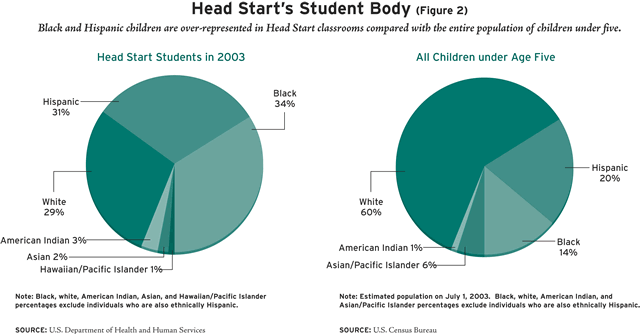
A New Mission
Data on school readiness for children entering Head Start in 1997 and 2001 show that children start the program with test scores far below average. Their performance improves slightly after a year in Head Start, but not enough to make a real difference in the achievement gap (see Figure 3). These striking differences upon the completion of Head Start translate into equally stark differences in school-age test scores, high-school graduation rates, college attendance, and earnings in the workforce.
These sobering facts convinced the Bush administration that Head Start needed to be retooled to focus on getting children ready to learn. The plan began with the Good Start, Grow Smart initiative, whose purpose was to retrain Head Start teachers and to bring accountability to the program. In effect, Bush is overruling the Cooke committee by making school readiness–an easily measurable outcome–the single most important goal of Head Start.
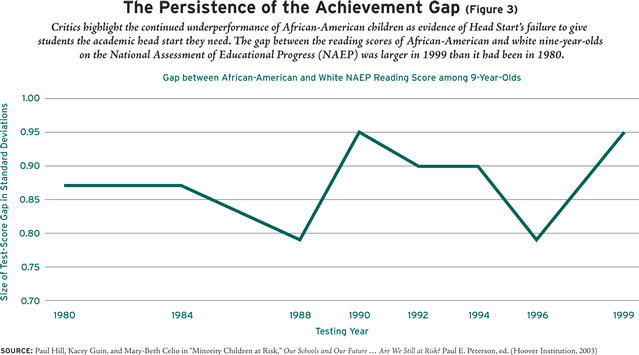
The shift in emphasis from comprehensive services to intellectual development has provoked strong opposition from Head Start’s stakeholders. The National Head Start Association was so opposed to the teacher-training and curricular aspects of the Good Start, Grow Smart initiative that the chairman of the association’s board, Ron Herndon, took the remarkable step of sending a letter to all Head Start programs, asking them to boycott the national teacher-training session the administration had planned for November 2002. The association’s board believes, Herndon wrote, that “local parents, staff and governing boards, and not the federal government, are in the best position to determine how to improve the operation of their program.” Even so, more than 2,000 Head Start teachers and administrators attended the training session.
The president’s budget for 2004 contained an even more inflammatory proposal: to turn Head Start over to the states. This would overturn the Cooke committee’s other crucial recommendation, that there be no middleman between the federal government and local Head Start programs. In return, states must promote school readiness in a more focused and sustained manner than Head Start programs have been willing to do. States must also meet several other conditions, including: 1) working with the public schools to define the academic and social skills that five-year-olds must possess in order to succeed in kindergarten; 2) developing preschool activities and materials that help poor children acquire these skills; 3) outlining an accountability program for determining whether four-year-olds are learning these skills; 4) maintaining state spending on preschool programs; and 5) continuing to provide comprehensive services.
The reasoning behind the Bush administration’s devolution proposal is twofold. First, as Table 1 shows (page 28), several streams of federal and state funding support preschool education and child care. All of these streams, except Head Start, are controlled to some degree by the states. It makes little sense, says the Bush administration, to have state governments in charge of most funds for preschool, but to bypass them with regard to the single biggest preschool program. The administration argues that the states should be able to align all of the funds available for preschool and child care in the service of a coherent statewide plan for improving the education of disadvantaged children.
The second reason is that Head Start programs have been unwilling to accept responsibility for closing the achievement gap. The devolution proposal requires states to do so. Moreover, the federal No Child Left Behind Act, enacted in 2001, gives states new incentives to improve preschool instruction. As demonstrated by four decades of research, it is exceptionally difficult for schools to erase the deficits poor and minority children have accumulated by the time they start school at age five. Thus many researchers, educators, and policymakers now believe that high-quality preschool is a prerequisite for improving the achievement of disadvantaged students. Given the opportunity to control Head Start funds and the flexibility to combine all the funds available for early education, states should be highly motivated to build comprehensive preschool programs for poor children.
Nonetheless, the administration’s agenda faces strong opposition from both congressional Democrats and the Head Start community. Senator Christopher Dodd of Connecticut told the New York Journal News that the president’s proposal would “absolutely destroy this program.” At a Brookings Institution forum in May, California representative George Miller likened turning Head Start over to the states to “handing your children over to Michael Jackson.” Many of the nation’s leading newspapers have also adopted forceful editorial stances against devolution. In general, the opposition to Bush’s proposal to give states increased responsibility for Head Start hinges on three arguments: 1) Head Start, as constituted, is an immensely successful program that should not be toyed with; 2) there is little evidence that states can do a better job than Head Start programs of improving children’s school readiness; and 3) states, especially in the current budget environment, may try to reduce spending on Head Start in order to use the money for other purposes.
The National Head Start Association has maintained its exceptionally critical position regarding the president’s proposal. When the president unveiled the devolution plan in February 2003, the association’s president and CEO, Sarah Greene, called the proposal a “potential disaster.” Writing in USA Today, Greene claimed that the administration’s real goal was “not to help Head Start children but rather to dismantle Head Start.” When Bush visited a Maryland Head Start center in July 2003 to explain and defend his agenda, the association unleashed a barrage of criticism. Asked if she had attended the president’s visit, Greene said that she didn’t “have time for floor shows.”
The association’s national office sent Head Start directors a letter with detailed instructions about how to lobby against the Bush proposal. Parents were encouraged to seek help in their lobbying from Head Start staff members. The Bush administration, concerned that Head Start programs were using federal resources, including paid staff, to support lobbying, sent Head Start programs a letter of caution, signed by Windy Hill, the national director of Head Start. The letter warned local programs that they would be subject to penalties if they used government resources to lobby Congress. The National Head Start Association responded by bringing suit against the administration in federal court for threatening local programs and trying to create a “chilling effect” on actions that parents and Head Start staff might take to save Head Start. The suit was subsequently withdrawn, but the tensions between Head Start’s supporters and the Bush administration remain.
Meanwhile, the administration negotiated a compromise with House Republicans. The administration agreed to scale back its broad devolution plans in favor of a pilot project. Up to eight states would be authorized to conduct demonstration programs testing whether state control of Head Start actually leads to better coordination of preschool programs, greater emphasis on school readiness, improvement in poor children’s preschool test scores, and progress in closing the achievement gap between poor and advantaged students. At this writing, the compromise legislation has passed the House by merely one vote and appears headed for an equally rocky reception in the Senate.
In several respects, the House’s compromise legislation is an improvement over the administration’s plan to allow every state to assume control over Head Start. As the administration recognizes, Head Start is a good program with a decent track record. Studies show that Head Start provides higher-quality care and education than most child-care facilities and even most state-sponsored preschool programs. Moreover, if we ignore the inflated rhetoric being used by those defending Head Start, their major arguments against the administration proposal are reasonable. So rather than abandon a modestly successful program in our attempt to promote equality of education, the best policy would be to let a few states have more control of Head Start funds, carefully study their subsequent reforms, and then determine future policy based on solid evidence.
Whatever the outcome, the Bush administration should be commended for taking on a politically difficult issue and sticking to its agenda, despite Head Start’s overwhelming popularity. For too long, Head Start has been merrily rolling along, enjoying ever more generous increases in funding, without demonstrating its value. Its stakeholders may take comfort in turn by spreading false claims of success or in excusing its ineffectiveness by lowering expectations. After all, they argue, no one should expect a single year of preschool to overcome the difficulties of being raised in a troubled family or neighborhood. True, perhaps. But these claims provide little comfort to the disadvantaged children who find themselves behind from the second the starter’s gun goes off. The greatest challenge may come when even the overhaul of Head Start fails to change things much, as I expect it may. Will we then be willing to pay for preschool teachers with college degrees, who will replace the parents and poorly paid staff who presently work in Head Start centers? For two years of preschool education? Three years? There is every reason to doubt that the nation’s policymakers are ready to take the politically difficult and potentially expensive steps that will be necessary to achieve Johnson’s vision of equality of education as a fact and a result.
-Ron Haskins is a senior fellow at the Brookings Institution and a senior consultant at the Annie E. Casey Foundation.


